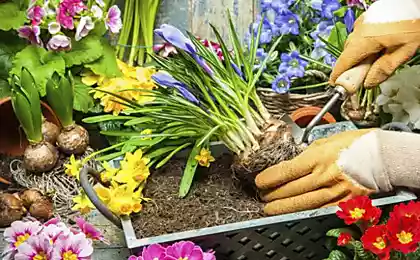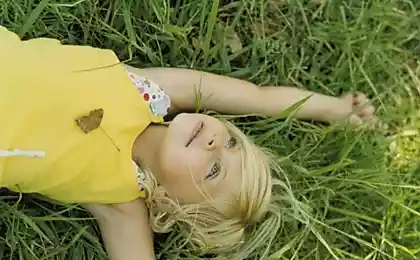174
How to prolong the flowering of panty eyes
Violas, or panty eyes, grow in many gardens. And if you create them the right conditions, they will bloom from early spring to snow, without exaggeration - I last autumn, the viola even survived the first October frosts, with the onset of the thaw continued to bloom and under the snow in November went in flowers to this spring at the end of April again please flowers. So how do you do that?
Where it is better to plant violas Advice from practice: you want to prolong the flowering of violas - plant them in different parts of the garden. In a sunny place, they will bloom earlier, but in the summer heat they can stop blooming altogether. In the penumbra, the flowers will appear later and may not be so numerous, but here they are not afraid of heat, and therefore you can count on continuous flowering.
It is important that the soil in the selected area is fertile and retains moisture well - if the viola will suffer from drought and malnutrition, this will certainly affect its appearance. The best option is a fertile loam with a neutral soil reaction. Do not plant viola in lowlands where water may stagnate in the spring or after heavy summer rains: there is a high probability of plant death.
To flowering was abundant and long-lasting, the violas will have to be taken care of. They do not require much: in dry times we water, do not forget to loosen and weed (young plants are especially sensitive to this - weeds are able to drown them out). If the plants are grown in containers (boxes, hanging baskets, etc.), watering should be done regularly, without waiting for the soil to dry out.
Feeding will be useful. Before planting, it is recommended to make potash and phosphorus fertilizers, at the very beginning of the formation of buds, feed the plants with nitrophosic (1 tablespoon per 10 liters of water), and during flowering, pour under the root a solution of Agricola-7 in the same proportion.
If you notice that the viola has become worse than blooming, new buds do not form or are formed weakly, prune the plants, leaving stems 10-12 cm long, abundantly water and feed - so you stimulate the growth of young shoots and a new wave of flowering.
Faded flowers are recommended to be regularly removed, and stretched shoots shortened, but you can not do this if you want to use all the opportunities for reproduction of the viola. I have not noticed that such procedures significantly affect the duration or abundance of flowering.
If you have different age violas in your garden, their flowers will please the eye all season. Therefore, it is worth using all available methods of reproduction, especially, it is quite simple.
You can sow viola in several terms: sown in January-February, they will bloom already by the end of the first spring - early summer (although it is not too easy to grow such seedlings: in the warmth of apartments, with a lack of light, the seedlings stretch out and turn out very weak). Seedlings of March sowing will give the first flowers in the second half of summer; it is easy to grow it. Both those and other plants with a safe wintering will bloom abundantly next year, starting in early spring.
If you sow violas in summer (June-July) and plant them in a permanent place in August, you will see their flowering next spring. The advantage of summer sowing is the ability to sow directly on the bed, without hassle with pots, illumination and other "joys" of home seedlings.
Many varieties of violets give self-seeds, and if you do not remove flowernoses with seed boxes, you can get healthy and strong plants at all without any effort - in the spring they will only be transplanted to the right place in the garden.
If you do not want to grow seedlings from seeds yourself, you can buy a ready-made one - in the spring the choice of flowering violets is usually large. Then the most successful varieties you can easily save and multiply vegetatively: cuttings or cuttings. And make a successful purchase will help the article How to choose the right flower seedlings.
Many varieties of violas form long lateral shoots. In early autumn (September), they are carefully (so as not to damage) pinned to the ground and steeped. Until the end of the season, they usually take root, and in the spring, young violas can be deposited in a permanent place. The beginning of their flowering depends on how strong and well-formed the breeding will be - as a rule, this happens by the end of spring (in May).
The snags are not bad, although I have had some failures. But this method allows much faster than the seedling method, to obtain flowering plants. In addition, the varietal signs are preserved.
In order for the plant to actively form lateral shoots, stretched out, it is advised to shade slightly. But not all varieties need it - many branch perfectly without additional effort on our part.
For the first time I tried this winter. My spontaneous experiment with violas began during the February thaw. Later I read that you can cut the violas from May to July, and by early autumn, rooted plants are planted in a permanent place.
As cuttings, apical shoots are used, which should have 2-3 nodes. I rooted them in pots, at first covering them with transparent plastic glasses. In the warm season, cuttings can be planted on a seedling bed, covering with film for the first time. It is important that the cuttings do not get direct sunlight, and the soil was always moistened. Rooting takes, on average, 3-4 weeks. My February pets are already blooming.
Source: www.7dach.ru
Where it is better to plant violas Advice from practice: you want to prolong the flowering of violas - plant them in different parts of the garden. In a sunny place, they will bloom earlier, but in the summer heat they can stop blooming altogether. In the penumbra, the flowers will appear later and may not be so numerous, but here they are not afraid of heat, and therefore you can count on continuous flowering.
It is important that the soil in the selected area is fertile and retains moisture well - if the viola will suffer from drought and malnutrition, this will certainly affect its appearance. The best option is a fertile loam with a neutral soil reaction. Do not plant viola in lowlands where water may stagnate in the spring or after heavy summer rains: there is a high probability of plant death.
To flowering was abundant and long-lasting, the violas will have to be taken care of. They do not require much: in dry times we water, do not forget to loosen and weed (young plants are especially sensitive to this - weeds are able to drown them out). If the plants are grown in containers (boxes, hanging baskets, etc.), watering should be done regularly, without waiting for the soil to dry out.
Feeding will be useful. Before planting, it is recommended to make potash and phosphorus fertilizers, at the very beginning of the formation of buds, feed the plants with nitrophosic (1 tablespoon per 10 liters of water), and during flowering, pour under the root a solution of Agricola-7 in the same proportion.
If you notice that the viola has become worse than blooming, new buds do not form or are formed weakly, prune the plants, leaving stems 10-12 cm long, abundantly water and feed - so you stimulate the growth of young shoots and a new wave of flowering.
Faded flowers are recommended to be regularly removed, and stretched shoots shortened, but you can not do this if you want to use all the opportunities for reproduction of the viola. I have not noticed that such procedures significantly affect the duration or abundance of flowering.
If you have different age violas in your garden, their flowers will please the eye all season. Therefore, it is worth using all available methods of reproduction, especially, it is quite simple.
You can sow viola in several terms: sown in January-February, they will bloom already by the end of the first spring - early summer (although it is not too easy to grow such seedlings: in the warmth of apartments, with a lack of light, the seedlings stretch out and turn out very weak). Seedlings of March sowing will give the first flowers in the second half of summer; it is easy to grow it. Both those and other plants with a safe wintering will bloom abundantly next year, starting in early spring.
If you sow violas in summer (June-July) and plant them in a permanent place in August, you will see their flowering next spring. The advantage of summer sowing is the ability to sow directly on the bed, without hassle with pots, illumination and other "joys" of home seedlings.
Many varieties of violets give self-seeds, and if you do not remove flowernoses with seed boxes, you can get healthy and strong plants at all without any effort - in the spring they will only be transplanted to the right place in the garden.
If you do not want to grow seedlings from seeds yourself, you can buy a ready-made one - in the spring the choice of flowering violets is usually large. Then the most successful varieties you can easily save and multiply vegetatively: cuttings or cuttings. And make a successful purchase will help the article How to choose the right flower seedlings.
Many varieties of violas form long lateral shoots. In early autumn (September), they are carefully (so as not to damage) pinned to the ground and steeped. Until the end of the season, they usually take root, and in the spring, young violas can be deposited in a permanent place. The beginning of their flowering depends on how strong and well-formed the breeding will be - as a rule, this happens by the end of spring (in May).
The snags are not bad, although I have had some failures. But this method allows much faster than the seedling method, to obtain flowering plants. In addition, the varietal signs are preserved.
In order for the plant to actively form lateral shoots, stretched out, it is advised to shade slightly. But not all varieties need it - many branch perfectly without additional effort on our part.
For the first time I tried this winter. My spontaneous experiment with violas began during the February thaw. Later I read that you can cut the violas from May to July, and by early autumn, rooted plants are planted in a permanent place.
As cuttings, apical shoots are used, which should have 2-3 nodes. I rooted them in pots, at first covering them with transparent plastic glasses. In the warm season, cuttings can be planted on a seedling bed, covering with film for the first time. It is important that the cuttings do not get direct sunlight, and the soil was always moistened. Rooting takes, on average, 3-4 weeks. My February pets are already blooming.
Source: www.7dach.ru
Engineers from Florida presented a running robot
Scientists have found a natural molecule to treat type 2 diabetes mellitus type






















